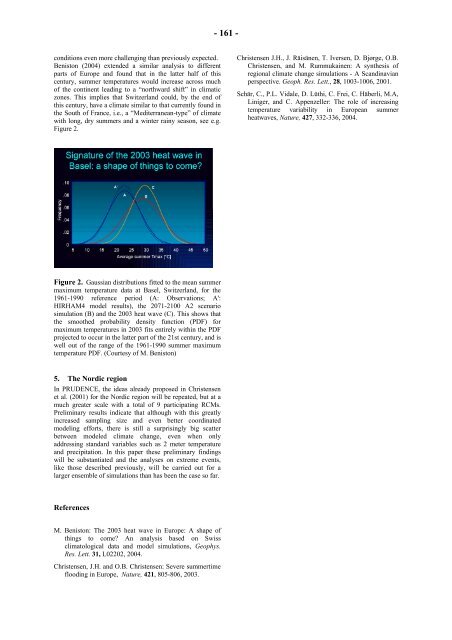Fourth Study Conference on BALTEX Scala Cinema Gudhjem
Fourth Study Conference on BALTEX Scala Cinema Gudhjem
Fourth Study Conference on BALTEX Scala Cinema Gudhjem
You also want an ePaper? Increase the reach of your titles
YUMPU automatically turns print PDFs into web optimized ePapers that Google loves.
c<strong>on</strong>diti<strong>on</strong>s even more challenging than previously expected.<br />
Benist<strong>on</strong> (2004) extended a similar analysis to different<br />
parts of Europe and found that in the latter half of this<br />
century, summer temperatures would increase across much<br />
of the c<strong>on</strong>tinent leading to a “northward shift” in climatic<br />
z<strong>on</strong>es. This implies that Switzerland could, by the end of<br />
this century, have a climate similar to that currently found in<br />
the South of France, i.e., a “Mediterranean-type” of climate<br />
with l<strong>on</strong>g, dry summers and a winter rainy seas<strong>on</strong>, see e.g.<br />
Figure 2.<br />
Figure 2. Gaussian distributi<strong>on</strong>s fitted to the mean summer<br />
maximum temperature data at Basel, Switzerland, for the<br />
1961-1990 reference period (A: Observati<strong>on</strong>s; A':<br />
HIRHAM4 model results), the 2071-2100 A2 scenario<br />
simulati<strong>on</strong> (B) and the 2003 heat wave (C). This shows that<br />
the smoothed probability density functi<strong>on</strong> (PDF) for<br />
maximum temperatures in 2003 fits entirely within the PDF<br />
projected to occur in the latter part of the 21st century, and is<br />
well out of the range of the 1961-1990 summer maximum<br />
temperature PDF. (Courtesy of M. Benist<strong>on</strong>)<br />
5. The Nordic regi<strong>on</strong><br />
In PRUDENCE, the ideas already proposed in Christensen<br />
et al. (2001) for the Nordic regi<strong>on</strong> will be repeated, but at a<br />
much greater scale with a total of 9 participating RCMs.<br />
Preliminary results indicate that although with this greatly<br />
increased sampling size and even better coordinated<br />
modeling efforts, there is still a surprisingly big scatter<br />
between modeled climate change, even when <strong>on</strong>ly<br />
addressing standard variables such as 2 meter temperature<br />
and precipitati<strong>on</strong>. In this paper these preliminary findings<br />
will be substantiated and the analyses <strong>on</strong> extreme events,<br />
like those described previously, will be carried out for a<br />
larger ensemble of simulati<strong>on</strong>s than has been the case so far.<br />
References<br />
M. Benist<strong>on</strong>: The 2003 heat wave in Europe: A shape of<br />
things to come? An analysis based <strong>on</strong> Swiss<br />
climatological data and model simulati<strong>on</strong>s, Geophys.<br />
Res. Lett. 31, L02202, 2004.<br />
Christensen, J.H. and O.B. Christensen: Severe summertime<br />
flooding in Europe, Nature, 421, 805-806, 2003.<br />
- 161 -<br />
Christensen J.H., J. Räisänen, T. Iversen, D. Bjørge, O.B.<br />
Christensen, and M. Rummukainen: A synthesis of<br />
regi<strong>on</strong>al climate change simulati<strong>on</strong>s - A Scandinavian<br />
perspective. Geoph. Res. Lett., 28, 1003-1006, 2001.<br />
Schär, C., P.L. Vidale, D. Lüthi, C. Frei, C. Häberli, M.A,<br />
Liniger, and C. Appenzeller: The role of increasing<br />
temperature variability in European summer<br />
heatwaves, Nature, 427, 332-336, 2004.













